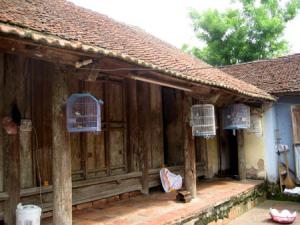Coc Thon Hamlet: A refuge for ancient, traditional houses

As it is probably with most communities today, urbanization has become an irresistible, almost natural process of development. And Vietnam is clearly not an exception. Surrendering to the call of modernization, beautiful, ancient homes with traditional architecture and even rich histories are fast becoming extinct.
Cu Da Village in the suburbs of ${bigcity_Hanoi:"Hanoi"} is a primary example of this 'surrender to modernization' wherein at a time when residents gained a surplus in their income, they immediately destroyed their stately homes in exchange for more modern, 'hip' houses.
But Coc Thon Hamlet near Duong Lam Village is a pleasent exception to this seeming trend. In contrary to most communities today, Coc Thon Hamlet preserves old houses. In fact, almost 200 ancient houses can be found in the hamlet, 60 of which were build in the late 19th century. But unlike Duang Lam Village which is known for its ancient houses, Coc Thon Hamlet sits still quiet and unknown in its own little world, much like the history its preserving.
Unlike Duong Lam Village which, though preserves old houses as well, Coc Thon Hamlet doesn’t have the “polished” look that the former has. The hamlet is typical of a North Vietnamese landscape with wooden buildings; old, brown tiles; and green rice fields. And it is this provincial, natural beauty that makes Coc Thon Hamlet stand out from most modernizing communities today.
One of the most beautiful homes in Coc Thon Hamlet is a 200-year old, six-compartment house owned by Nguyen Ba Tao. Made of cedar wood, laterite stones, lacquered boards, carved wooden frame, altar, narrow high desk, partitions, pillars, wooden panels and Chinese engravings, it is a perfect example of a traditional Vietnamese home. In fact the house is so impressive that it was visited by a group of scientists from the University of Osaka from Japan and the Hanoi Architecture University.
La Thi Du, head of the Coc Thon Hamlet, stated that 20 of the 60 ancient houses in the hamlet are even one-of-a-kind. According to local legends, it took 10 years to build such unique houses in the past. It was said that in the past, men went into the forests of Ba Vi mountains to look for high quality, durable wood in order to build a house. The wood was stored there until there was enough to make a house.
Quach Thi Hong, culture officer of Cam Thuong Ward, stated that house in the locality ten years ago were numbered for preservation purposes in the future. Aside from the local government encouraging the residents to preserve their old houses, the villagers themselves valued their traditions and were against the urbanization happening in Vietnam.
As mentioned, the local government encourages local residents to preserve their ancient houses. But that’s all there is to it. There is no official policy on the preservation itself. As such, president of Cam Thuong Ward’s Fatherland Front Nguyen Tien Lien proposed that a group of experts should be hired by the government to determine the official age of such historical houses. Moreover, a specific budget should be set aside for the preservation process since not all owners can afford the high cost of maintaining such old, beaten down houses. If the government and Vietnam itself wants to preserve a part of its history, these issues should be addressed immediately before history will be left eaten away, figuratively and literally, by worms and termites.









